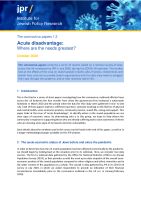Acute Disadvantage: Where are the needs greatest?
Author(s)
Publication Date
October 2020
Publication Place
Publisher
Abstract
This paper, the third in our series examining the effects of the coronavirus pandemic on the UK Jewish population, explores how Jewish households have been impacted financially over the first few months of the crisis (March to July 2020).
The study uses four measures that households may have had to take to identify those showing signs of ‘acute disadvantage’: having had to use food banks; having had to reduce the size of meals because there was not enough money to buy food; having had to borrow money or use credit; and/or struggling to pay bills (for example food and energy).
It finds that 7% of Jewish households were in this position at the time of the survey, with a further 15% of households at some risk of becoming acutely disadvantaged should their economic circumstances deteriorate. Strictly Orthodox households and single-parent households are found to be most likely to be vulnerable. However, overall, it demonstrates that in general, Jewish households entered into the pandemic in stronger economic health that the UK population in general, and all other religious and ethnic sub-groups.
The study goes on to look at some of the steps Jewish households are taking to manage their economic challenges, and to consider how the Jewish community might best support families known to be struggling.
The study uses four measures that households may have had to take to identify those showing signs of ‘acute disadvantage’: having had to use food banks; having had to reduce the size of meals because there was not enough money to buy food; having had to borrow money or use credit; and/or struggling to pay bills (for example food and energy).
It finds that 7% of Jewish households were in this position at the time of the survey, with a further 15% of households at some risk of becoming acutely disadvantaged should their economic circumstances deteriorate. Strictly Orthodox households and single-parent households are found to be most likely to be vulnerable. However, overall, it demonstrates that in general, Jewish households entered into the pandemic in stronger economic health that the UK population in general, and all other religious and ethnic sub-groups.
The study goes on to look at some of the steps Jewish households are taking to manage their economic challenges, and to consider how the Jewish community might best support families known to be struggling.
Topics
Coronavirus/Covid Economy Family and Household Finance Haredi / Strictly Orthodox Jews Main Topic: Other Surveys Poverty
Genre
Geographic Coverage
Original Language
Series Title
Series Number
1.3
Link
Download can be found on page, Acute Disadvantage: Where are the needs greatest?
Bibliographic Information
Acute Disadvantage: Where are the needs greatest?. . October 2020: https://archive.jpr.org.uk/object-1364




